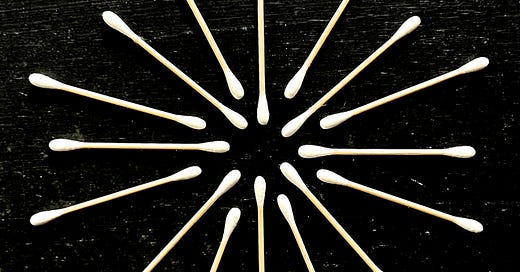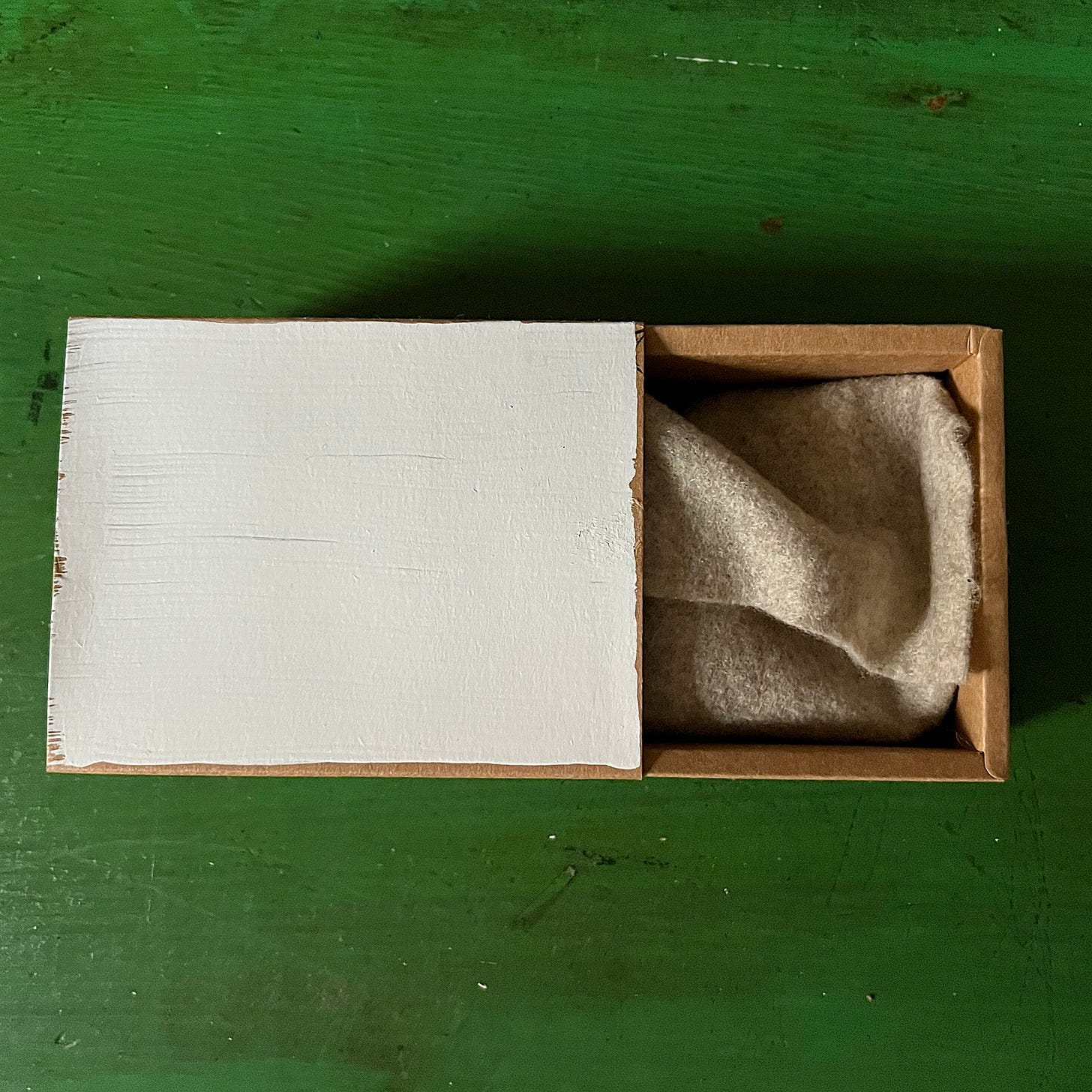Newsletter #44
We are not separate from nature; we are an integral part of it. Our survival is just as dependent on the soil, air, and water as it is on our hearts, lungs, and brains. (cont.)
Our existence is rooted in the Earth, just as any tree or flower.
~Zach Bush
Hello Friends!
Welcome to all subscribers and a special big thank you to all paid subscribers! I just received a warning that my newsletter is too long, so the intro will have to be short so I don’t lose any of the posts in this issue from Q-tips to Forever Chemicals, a Lit Pathway in the Netherlands to a lovely and short animated film titled A Future Begins, a company that is helping Bring Life Back to Waterways and possibly my last REF’s journal for this year. Hope you liked the intro quote from Zack Bush! Onwards!
#1- Q-tips
I’m a Q-tip user and many years ago, before I knew there was a healthier choice, I probably used some of the ones with pink plastic sticks, the same kind you see in images of trash piled up on beaches or just as worse, harming marine life.
My fresh Q-tips
I have often referred to myself as my own best customer. When I launched my first online store in January 2009, it was to offer healthy alternatives to conventional products, the kinds that most people didn’t know existed and I also needed and wanted to use. I still use them from the organic reusable cotton produce bags for bagging produce at the market to the glass spray bottles I use to make my own cleaning products to the sturdy cloth market bags and cloth kitchen towels. They are all still my favorites!
Another favorite are these bamboo Q-tips (also known as cotton earbuds). These are made with bamboo, which is a renewable resource, compostable and biodegrades safely back into the soil, without polluting it.
The other handy thing about these, is they come in a biodegradable craft box. I prefer to reuse the box and in fact, I search for healthy products that have packaging that is reusable. If you have been following me on Instagram, you already know this. So instead of adding it to my compost pile, I have turned it into a secret surprise box for my grandson. He’s a little too young to play with it, but soon enough, he will be tucking in these littles in their felt blanket in their napping box (elephant, tiger, monkey).
The same earth friendly Q-tips I use are available in my store on Amazon
*As an Amazon Associate I earn from qualifying purchases*
#2 -How to Avoid Forever Chemicals
In case you haven’t read about these already, what is referred to as ‘forever chemicals,’ also known as PFAS, are a widely used class of nearly 5,000 synthetic chemicals that have been used in manufacturing since the 1940s. They are oil-water-and heat-resistant, making them profoundly useful and popular in all manner of products.
These are the chemicals that make carpets stain resistant and fast food packaging able to repel grease and water, in fire-fighting foams, and what gives nonstick cookware, it’s non-stickiness.
They’re known as “forever chemicals,” because the molecular bonds that form them can take many, many years to degrade, meaning that they accumulate both in the environment and in our bodies.
There is more. PFAS are chemical compounds associated with cancer and other health risks. While the CDC says it can be difficult to completely eliminate the risk of exposure, there are things we can do to minimize it.
Avoid
-non-stick cookware. (I use stainless steel or cast iron).
-stain and water-resistant clothing and furniture
- items that contain the words “fluoro” and “perfluoro.”
-take out containers. (bring your own glass or stainless steel reusable containers)
Do
-vacuum regularly can help remove PFAS from your carpets.
-remove shoes upon entering your home. (less tracking in of pollutants from outside).
-when choosing a cosmetic or personal care product, refer to the EWG’s Skin Deep report. It reviews thousands of products, and based on its ingredients, gives them a health score. (one of my favorite trusted resources).
- buy food fresh, and unpackaged as the packaging often contains harmful chemicals.
-wash your fruits and vegetables thoroughly before eating them.
Also, using a water filter at home is a good way to remove PFAS from drinking water, as well as heavy metals and micro-plastics.
Here are the Best Water Filters for removing Forever Chemicals
The most common type of home water filtration are freestanding counter-top units that also serve as water dispensers. Use of home filters can help remove PFAS.
The Travel Berkey was found to be overall the best at reducing PFAS (99.9%), as well as microplastics, and heavy metals from drinking water.
Other good choices for Water Pitcher Filters are Aquagear, Brita Soho with Longlast Filter and Aquasana The Clean Water Machine.
Source: Consumerlab.com
Read more about forever chemicals
*As an Amazon Associate I earn from qualifying purchases*
#3- The Van Gogh Path
I remember reading about this a few years ago, and thought it was so wonderful and I still do. I love projects that benefit the community, and are self-sustaining. Called the “Van Gogh Path,” this light emitting bicycle path glows at night inspired by Van Gogh’s Starry Night. Lit by thousands of twinkling stones, the path charges during the day and glows at night, enhancing public safety. It’s located in the same area that Van Gogh lived in 1883-1885 in Eindhoven and Nuenen, the Netherlands. You could see it for yourself if you find yourself in the Netherlands.
Designed by social design lab, Dutch artist and innovator Daan Roosegaarde. His team connects people and technology in installations that improve daily life in urban environments, spark the imagination and fight the climate crisis. Clean air, clean water, clean energy, and clean space are their values, and light is their language.
Watch a video of the lit pathway. It’s beautiful!
Learn ore about Studioroosegaarde here
In addition, watch Daan Roosegaarde talk about a project he is working on at the moment in Bali, where he is designing the world’s largest firefly garden. Wishing him huge success!
#4- Bringing Life Back to the Water
-urban water restoration-
We’ve all seen them. City waterfronts that feel devoid of life and nature. Cities typically contain many miles of water edge comprised predominantly of hard concrete, steel sheet pile, or stone work. The potential is lost for waterways to become ecological corridors, waterscapes that provide sanctuary for a wide range of species as well as a place for people to escape the hustle and bustle of the city.
Biomatrix is providing an ecological solution.
By integrating ecology and engineering, Biomatrix is harnessing the power of nature to provide clean water in canals, rivers, ponds and lakes. They create habitats and improve biodiversity, designing beautiful floating ecosystems with a support structure that brings life and vitality to water bodies with hard edges and limited ecological function.
The Biomatrix system provides habitat for birds, fish and pollinators, increasing biodiversity and adding beauty and green space to urban environments.
One of their most recent projects is a new archipelago of 5 Biomatrix floating islands that were installed in Amsterdam. These floating islands will support wildlife, providing habitat stepping-stones for important local species, with specific features designed to accommodate species of local importance such as the Eurasian Water Shrew. These islands form an important connection feature in the Dutch National Ecological Network. The University of Amsterdam is monitoring the ecosystems along with Amsterdam City Council. They will study which species gravitate towards and utilize these Floating Ecosystems.
Watch a video about their work
Watch a second video that shows a refuge for wildlife in an urban jungle
Can your community benefit from a floating ecosystem? Learn more from Biomatrix
#5- River’s Edge Farm Garden Journal
-October 15th-October 31st-
This may be the last journal for 2023, as things are rapidly winding down at River’s Edge Farm NY, which is just as well because my mood is in alignment with nature, and we are both in a hibernation state of mind.
But before that happens, there is still plenty to do. I’m still picking chard, arugula, kale, parsley, shiitake mushrooms and the last of the jalapenos. With so much chard to eat, I par-boiled (save the ribs and stems), then puréed it. Once the purée had cooled off in a bowl, I rolled it into a log and put it in the freezer. Once frozen, I’ll slice it into thick slices and store it ready to use in glass freezer safe jars. It will be easy to add it to mashed potato, or soup. I saved the chard stems and ribs in a jar and added them to sautéed vegetables, seaweed and brown rice.
The arugula was eaten for lunch, as was the parsley. I had so many shiitake mushrooms that I cooked them with garlic from the garden, added them to a plate to cool down and then filled several 6-ounce jars with them and into the freezer. I don’t love dehydrated shiitake mushrooms as I find them too tough, even after a good long soak. I don’t mind golden oysters though, as I they are tender and without a rubbery texture. The coriander I dried and stored in a small glass jar. I love having my own coriander spice! The black raspberries were frozen over the summer so I take out 1 cup full from the freezer, and let them soften enough to be pureed in a blender. Delicious with a small cup of probiotic yogurt, and sprinkled with wheat germ and ground flax.
P.S. I also witnessed several bees napping in the flowers. Here is one in a Mexican sunflower.
Apparently, these are male bees, which shelter right in the flowers that provide them with food. The female bees retreat to their nests to rest. Most of our native bees are solitary bees and don’t belong to a colony.
I also found a walking stick, of the Phasmatodea order of insects, walking up my door.
It’s completely harmless and looks just like a stick, and may even sway back and forth to more closely resemble a twig moving in the wind. Their biggest predators are bats, and also humans, the ones that are responsible for habitat destruction and pesticide use
#6- Short Animated Film: The Future Begins
Ten years after Irish animator and director Johnny Kelly (previously) brought us a charming stop-motion ad for Chipotle about a farmer’s return to organic methods, he’s back with an emotional sequel that revisits the now-aging protagonist.
The new short film, titled A Future Begins, follows the same mustached rancher as he struggles to maintain his pesticide-free fields and natural techniques amidst weather catastrophes and other struggles. When his son returns from college and a busy life in the city, the reunited family implements a range of sustainable technologies like solar panels, greenhouses, polyculture, and companion planting that make the farm thrive.
Watch the short film here
*************************************************************************************************************
The Rabbit Hole will be opening up soon! I’ll post the dates it will be open in November and December on my instagram page, so please follow me there for all my latest news.
Don’t forget to vote on November 7th, if your area is having elections. Local elections matter hugely. I voted using an absentee ballot just in case I can’t make it to the polls on the 7th.
Wishing you and your loved ones all the best always,
Priscilla















